S E A F R E I G H T IMPORTS AND EXPORTS.
The story of Sea Freight imports and exports – Since time immemorial, in other words, ever since ships were built and man made the decision to sail the seven seas, cargo has been transported via sea freight. Apart from transport via road or later rail, sea freight is the traditional way of transporting cargo. Not only is it the traditional way of transporting cargo, but sea freight – and the sea, the sailors and the ships – are steeped in tradition.
Sea Freight Imports and Exports; The Early Days.
Prior to cranes being used to load the ships, labourers would run up and down the gangway carrying goods off and onto the ship. At the bottom of the gangway stood the “Tallyman”, tallying on his lists everything that was discharged off, or loaded onto, the ship. Remember the old Harry Belafonte song : “Oh Mr Tallyman, tally me bananas…”? Since then, much has changed : we have moved from cargo ships that used to arrive in port and open their hatches, revealing layers and layers of bags, boxes and pallets, (now termed break bulk) all neatly stacked To “multi-purpose” vessels, carrying both “break-bulk” and containers to fully cellular (meaning they are purpose-built to only carry sea-going containers) vessels.
What has however not changed, is that the sea voyage is still a joint voyage in peril. It is an understood joint-peril undertaking between the captain of the ship and his crew, the owners of the ship and the owners of the cargo that the ship is carrying. As the ship sets sail for her next port of call, all involved in this journey have the same hope: may the sea be kind, the winds be favourable and may the ship arrive safely, all on board healthy, cargo intact, at her next destination.
And yet, in spite of the potential hazards of the waves, wind or weather, sea freight remains one of the most cost effective and reliable modes of transport, whether the cargo is small or large.
SEA FREIGHT IN SMALLER QUANTITIES:
LCL- Sea freight (less than full container loads) is charged on a weight / measure basis, whichever is the higher. The base unit of measure for ‘LCL’ cargo is 1 cubic meter or 1 ton.
SEA FREIGHT IN LARGER QUANTITIES:
FCL – Sea freight (Full container loads) is charged per container. There are 20’ general purpose containers, 40’ general purpose containers and all sorts of “special equipment” containers available. 20’ containers are also referred to as 6 meter containers while 40’ containers are also referred to as 12 meter containers in the metric system.
As a rule of thumb, a maximum of 26 tons / 32 m3 can be packed into a 20’ General Purpose and 26 tons / 67 m3 can be packed into a 40’ General Purpose container.
It’s interesting and important to note that the 40’ container holds roughly double the volume of the 20’ container but only about the same weight!
Obviously to pack the maximum permissible load into a container will not only require very precise packing, but prior to packing such heavy loads into a container, you need to find out whether such heavy loads are allowed to be transported on the roads. This applies to both the exporting and the importing country.
If you have any questions concerning sea freight imports and exports, whether on a full container load or less-than-full container load basis please feel free to contact us.
We are only too pleased to hear from you!
Remember: We speak the lingo, so you don’t have to!
